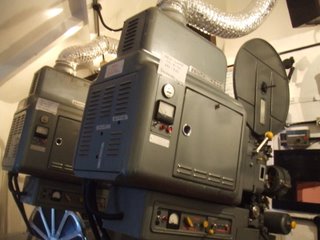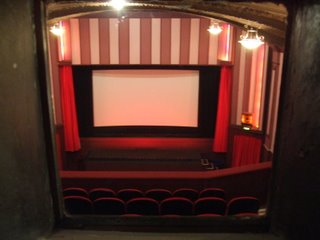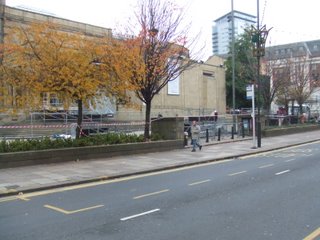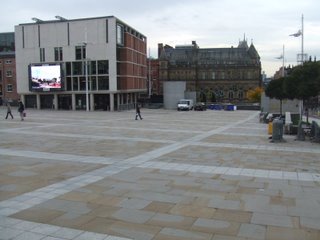
In 2005 the 270 seat cinema had 961 performances watched by 42,000 visitors generating £180,000 revenue from ticket and kiosk sales. HPPH is owned and operated by Leeds City Council, it is also a registered charity. It predominantly shows independent, art house and foreign language films, with children’s films being shown on a Saturday afternoon.
The Entertainment Management group visited HPPH on Monday afternoon, and had a tour and talk from Manager Wendy Cook. What follows is a brief summary of some of the key points made by Wendy during the visit.
Facilities Management
 In the independent cinema sector, it is not uncommon for one cinema to make use of another cinema’s hand-me-downs. This has been the case at HPPH where both carpets, seating and projectors which are 50-60 years old, (pictured left) from the now closed Lounge Cinema in Headingley were used to refurbish HPPH. There is also a clock next to the main screen (unusual for a cinema) which came from another cinema in Scotland.
In the independent cinema sector, it is not uncommon for one cinema to make use of another cinema’s hand-me-downs. This has been the case at HPPH where both carpets, seating and projectors which are 50-60 years old, (pictured left) from the now closed Lounge Cinema in Headingley were used to refurbish HPPH. There is also a clock next to the main screen (unusual for a cinema) which came from another cinema in Scotland. Any refurbishment needs to retain the existing character of the building, these include the cinema’s gas lights – which are still in working order. In the near future a new fire alarm system will be installed with costs expected to be £10,000 - £15,000, and the cinema roof is to be replaced in the next ten years. There are also hopes of a future extension to the current building with a second screen being installed, as well as a disabled toilet.
 The seats, and screen covered with the curtain - the clock is to the right of the screen
The seats, and screen covered with the curtain - the clock is to the right of the screenDisability Support
Due to the buildings age and listed status, modernisation is limited, this has meant limited access for wheel chair users. Under the reasonable adjustment clause of the Disability Discrimination Act (1995) HPPH can show subtitled films, and provide water bowls for guide dogs. There are plans to install a hearing loop to assist those who use a hearing aid.
Competition
The unique selling point of HPPH is the building itself along with its history. Competition locally from independent and art house cinemas comes only from Cottage Road Cinema in Headingley. However large multiplexes such as Vue Cinema at Kirkstall and in the Light do now sometimes show art house films that once would have not been associated with multiplexes. Due to the fact that HPPH only has one screen it is limited to only showing two or three performances per day, which puts it at a disadvantage to the larger multiplexes that have a greater capacity.
The Film Hire Process
HPPH can show films in traditional 35mm reel or digital formats (including DVDs). Historically, film distribution companies would charge either a minimum amount per film, or a percentage of door receipts. This would sometimes be as high as 35-40% in the first two weeks of a film being released, ‘big’ films such as Harry Potter and Sin City would inevitably cost more, often 50-60%.
Films are now hired through City Screen Virtual who are an independent booker that hire films from distribution companies. For this service HPPH pay a fee of £6,000 per year. There are also financial rewards for City Screen Virtual if HPPH receives over 32,000 visitors per year. This gives City Screen Virtual the incentive to give HPPH films that will attract good numbers of visitors – which is often down to how films are marketed, there is a clear relationship between promotion, and numbers of visitors per film.

The view of the screen from the projectionists room
Human Resources
The cinema has eleven members of paid staff, undertaking roles including projectionist, cleaner, and front of house, it also utilises a number of volunteer workers, who in return for their endeavours can watch performances free of charge.
Marketing
This was acknowledged as being ‘ad-hoc’ in the past, but now the cinema has a new website, and a marketing package that includes a brochure that features adverts from other entertainment attractions. HPPH rarely pay to advertise in other publications.
Other Factors
The location of HPPH is perceived as being ‘unsavoury’ by some visitors, other people have admitted that its location has put them off of visiting.
Audiences in the main comprise of students, long term ‘HPPH veterans’, and young professionals.
Advertising through Carlton Screen provides an additional regular income stream.
There is a ‘Friends of Hyde Park Picture House’ association whose patron is Ken Loach.

The Kiosk
Many thanks to Wendy Cook and Leeds City Council for an extremely interesting visit.

















 A variety of galleries and displays
A variety of galleries and displays